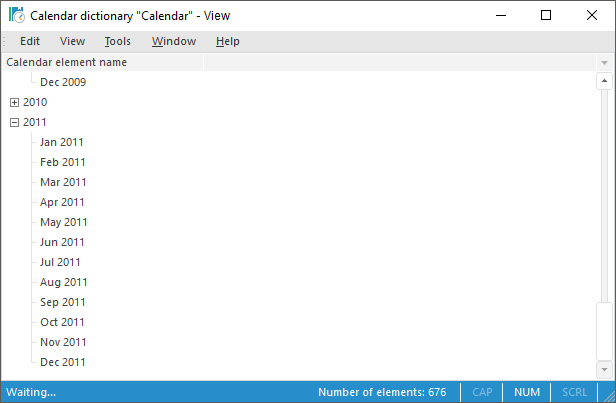

A calendar dictionary contains hierarchical view of time scale with defined drillthrough. The drillthrough is available by the following levels: years, 9 months, half-years, quarters, months, weeks and days. Dictionary contents is generated automatically depending on the specified parameters.
A calendar dictionary enables to dynamically define beginning and end of the time scale, tat is, this is a dynamic dictionary.
To build this type of dictionary, it is not necessary to create tables and link table elements. The user only needs to select calendar levels, whereas elements and their interaction are generated by the system:


The calendar dictionary wizard contains a number of basic paged described in the Working with Wizards section. The following pages are also available in the wizard:
Type/Actuality. Basic parameters are set which determine calendar hierarchy and start year and end year of calendar period.
Structure. Levels that are available in calendar hierarchy are specified.
Attributes. It is possible to create a set of advanced custom attributes that describe each element of the dictionary.
NOTE. It is available to create and work with calendar dictionaries only in the desktop application.
Calendar dictionary structure consists of a fixed set of blocks and indexes that are further used to bind source data to calendar elements. Each index is built on dictionary system attributes. Sets of blocks indexes change depending on which calendar type is selected or which levels are included into calendar structure.
Blocks are used to select only elements of specific levels. Each block has a primary unique index built on the Period Start Date (START_DATE) attribute. Depending on the selected block, the dates stored in the data source will be considered as start of years, months and other periods. The dictionary also has indexes that tale into account all calendar elements. Below is the list and contents of these indexes:
| Name (identifier) | Attributes included in index | Advanced |
| Primary key (INDEX_MAIN) | Calendar block type (BLOCK_TYPE) Period start date (START_DATE) |
Primary, unique. Always exists in dictionary structure. |
| Calendar element name (INDEX_NAME) | Calendar element name (NAME) | Always exists in dictionary structure. |
| Elements order (INDEX_ORDER) | Order (ORDER) | Unique. Always exists in dictionary structure. |
| Year number index (INDEX_ATTR_YEAR) | Year number (YEAR) | - |
| Half-year number index (INDEX_ATTR_HALF_OF_YEAR) | Half-year number (HALF_OF_YEAR) | - |
| Quarter number index (INDEX_ATTR_QUARTER) | Quarter number (QUARTER) | - |
| Month number index (INDEX_ATTR_MONTH) | Month number (MONTH) | - |
| Week number in year index (INDEX_ATTR_WEEK_OF_YEAR) | Week number in year (WEEK_OF_YEAR) | - |
| Day number in week index (INDEX_ATTR_DAY_OF_WEEK) | Day number in week (DAY_OF_WEEK) | - |
| Day number in month index (INDEX_ATTR_DAY_OF_MONTH) | Day number in month (DAY_OF_MONTH) | - |
| Day number in year index (INDEX_ATTR_DAY_OF_YEAR) | Day number in year (DAY_OF_YEAR) | - |
When setting up dimension bindings use the index that corresponds with calendar data stored in the data source.
See also: